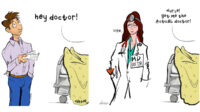Actually, our premise is a bit misleading. Doctors don’t want to be obstacles to innovation – they want a good reason to innovate. Saying a medical device or business model is “new”, “advanced”, or “cutting-edge” isn’t enough anymore. Savvy physicians want to try new things – they just want information and data on why they should and how any item or system will ultimately improve patient care. Trying something new just for the sake of innovation isn’t nearly enough to make them risk patient care.
A recent survey by Bain & Company discovered that organizations who believe physicians are obstacles to innovation are often the ones that have not “fully embraced physician input”. Whether it’s new reimbursement models, like fee-for-service versus bundled payments, or patient engagement tools like telemedicine, physicians want hard, cold evidence that adopting something new will improve care for their patients. Improving patient outcomes is in a physician’s DNA and anyone who wants them to innovate will have to meet that high standard of proof.
For example, here’s a quick snapshot that shows physician preference for relying on tried and true methods of delivering health care:
- Only 10% of physicians cite patient adherence initiatives as a “top tool for improving the quality of care”, while 38% say standard treatment protocols are a top tool.
- Only 5% name telemedicine as a top tool while 24% say wellness programs improve the quality of care.
Physician reticence to adopt change for change sake is also rooted in the crushing administrative burdens that most physicians must bear on a daily basis. If change means more documentation time or less reimbursement, it’s a non-starter. One recent study showed that physicians “spent 27.0% of their total time on direct clinical face time with patients and 49.2% of their time on EHR and desk work”.
One of the most powerful findings of the Bain & Company survey said more than 60% of physicians believe it’s going to become even more difficult to deliver high-quality care in the next two years because of “struggles to cope with a complex regulatory environment, increasing administrative burdens and a more difficult reimbursement landscape. After years of experimentation, physicians now want evidence that new models for care management, reimbursement, policy and patient engagement will actually improve clinical outcomes. Without it, they see little reason to alter the status quo and move toward widespread adoption.”
One doctor, James C. Salwitz, shed more light on the issue when he posted a guest blog on KevinMD.com. He said that because physicians are trained to practice evidence-based medicine, that discipline colors every decision of every day. When faced with change the question becomes, “How will this affect my patients?”
Salwitz writes, “No physician, once he/she gets something “right,” will easily change. It becomes hardwired into every action. How you greet each patient, how you take a history, how you record your decisions, how you organize treatment and even how you give bad news. Deviate from these lessons, and you know, deep down, the patient will suffer. It does not matter if there ‘might’ be a ‘better’ way. Doctors are highly conservative in their work style; they re-educate with great resistance, and rapid, dramatic innovation is nearly impossible.”
So, contrary to the opinion of those who would market into the healthcare space, or administrations who want to impose change on physicians, the point is not saving money or faster surgery. The question is, and always will be, pointed directly at patient outcomes.
Retired pathologist Richard L. Reece says physicians aren’t asking too much. Writing in MIT Technology Review, Dr. Reece maintained that adopting change slowly isn’t resistance, it’s wisdom. “We physicians are not Luddites or troglodytes. We are savvy about using the Internet, technology applications, and social media. For us, medicine mixes art and science. What we seek from patients are clues, constellations of signs and symptoms, and stories. We choose not to be reduced to data-entry clerks sorting through undigested computer bytes.”
That brings us back to the Bain & Company report. The physicians surveyed said they will embrace change, but only when it is rooted in facts about financial and patient benefits.
- Surgeons’ top criteria for purchasing medical equipment are product quality and patient outcomes.
- 88% said better patient outcomes was very important criteria for purchases.
- 89% said product “strongest product quality and reliability” was very important.
- When it comes to pharmaceuticals and drug choices, nonsurgical physicians said the most important factors influencing their prescribing decisions are:
- Patient outcomes: 94%
- Real-world evidence: 92%
- Safety profiles: 91%
Too much change, too soon, has actually slowed the pace of change in healthcare, an industry in desperate need of it. However, physicians are safeguarding their patients with proven methods of healthcare delivery until it is proven otherwise. Who can blame them? Whizbang technology may be fun at home in front of the television but it has no place in the operating suite or the emergency room until it’s tried and true. The sooner that healthcare organizations realize that fact, the sooner we can move the healthcare ship forward to more productive shores.




